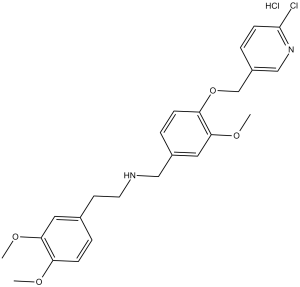SBE 13 HCl (SBE13; SBE-13), the hydrochloride salt of SBE13, is a novel, potent and selective Polo-like Kinase 1 (PLK1) inhibitor with potential antineoplastic activity. It exhibits >4000-fold selectivity over Aurora A kinase, Plk2, and Plk3, and inhibits PLK1 with an IC50 of 200 pM. SBE 13 induces a G2/M arrest and apoptosis in a number of cancer cell lines, while also decreasing cell proliferation. SBE 13 does not affect the cell cycle or the primary cells' ability to proliferate. When SBE13 and Enzastaurin are combined, HCT116(p53-/-) cells exhibit a synergistic decrease in cell proliferation and an increased induction of apoptosis.
Physicochemical Properties
| Molecular Formula | C24H28CL2N2O4 | |
| Molecular Weight | 479.4 | |
| Exact Mass | 478.142 | |
| Elemental Analysis | C, 60.13; H, 5.89; Cl, 14.79; N, 5.84; O, 13.35 | |
| CAS # | 1052532-15-6 | |
| Related CAS # | SBE13;775294-82-1 | |
| PubChem CID | 11948807 | |
| Appearance | white solid powder | |
| LogP | 5.865 | |
| Hydrogen Bond Donor Count | 2 | |
| Hydrogen Bond Acceptor Count | 6 | |
| Rotatable Bond Count | 11 | |
| Heavy Atom Count | 32 | |
| Complexity | 500 | |
| Defined Atom Stereocenter Count | 0 | |
| InChi Key | QBGSVDJLQQXEGG-UHFFFAOYSA-N | |
| InChi Code | InChI=1S/C24H27ClN2O4.ClH/c1-28-20-7-4-17(12-22(20)29-2)10-11-26-14-18-5-8-21(23(13-18)30-3)31-16-19-6-9-24(25)27-15-19;/h4-9,12-13,15,26H,10-11,14,16H2,1-3H3;1H | |
| Chemical Name | N-[[4-[(6-chloropyridin-3-yl)methoxy]-3-methoxyphenyl]methyl]-2-(3,4-dimethoxyphenyl)ethanamine;hydrochloride | |
| Synonyms |
|
|
| HS Tariff Code | 2934.99.9001 | |
| Storage |
Powder-20°C 3 years 4°C 2 years In solvent -80°C 6 months -20°C 1 month Note: Please store this product in a sealed and protected environment, avoid exposure to moisture. |
|
| Shipping Condition | Room temperature (This product is stable at ambient temperature for a few days during ordinary shipping and time spent in Customs) |
Biological Activity
| Targets | PLK1 (IC50 = 200 pM); PLK3 (IC50 = 875 nM) | ||
| ln Vitro |
|
||
| ln Vivo |
|
||
| Enzyme Assay | After a 13-hour release in the presence of SBE13, cells are lysed, double thymidine block is applied, and kinase is immunoprecipitated from lysates using antibodies in order to measure Plk1 kinase activity. To summarize, 800 μg of total protein are immunoprecipitated and then incubated for 2 hours at 4°C on a rotator with 1.5 μg of Plk1 antibody cocktail. Protein A/G Agarose beads are used in the immunoprecipitated protein collection process. Plk1 immunoprecipitates are incubated for 30 minutes at 37°C in kinase buffer with casein (1 μg) and [γ-32P]ATP (1 μCi). Kinase assay products are fractionated on 10% bis-tris-polyacrylamide gels, and after a 12- to 36-hour exposure, phosphorylated substrate is seen by autoradiography. Western blot analysis is performed on equal volumes of immunoprecipitates to verify that Plk1 protein is loaded equally in kinase reactions[1]. | ||
| Cell Assay | SBE13 is applied to the cells a day after subculturing. Normal culture medium is used to culture the control cells. SBE13 concentrations varied from 1 nM to 100 µM. One can calculate the growth rate of 1 x 105 cells per 6-well by counting the cells 24 hours, 48 hours, and 72 hours after treatment. Every time point is studied in triplicate using cell culture. | ||
| Animal Protocol |
|
||
| References |
[1]. Identification and validation of a potent type II inhibitor of inactive polo-like kinase 1. ChemMedChem. 2009 Nov;4(11):1806-9. [2]. Fate of primary cells at the G?/S boundary after polo-like kinase 1 inhibition by SBE13. Cell Cycle. 2011 Feb 15;10(4):708-20. Epub 2011 Feb 15. [3]. Biological impact of freezing Plk1 in its inactive conformation in cancer cells. Cell Cycle. 2010 Feb 15;9(4):761-73. Epub 2010 Feb 16. |
Solubility Data
| Solubility (In Vitro) |
|
|||
| Solubility (In Vivo) |
Solubility in Formulation 1: ≥ 2.5 mg/mL (5.21 mM) (saturation unknown) in 10% DMSO + 40% PEG300 + 5% Tween80 + 45% Saline (add these co-solvents sequentially from left to right, and one by one), clear solution. For example, if 1 mL of working solution is to be prepared, you can add 100 μL of 25.0 mg/mL clear DMSO stock solution to 400 μL PEG300 and mix evenly; then add 50 μL Tween-80 to the above solution and mix evenly; then add 450 μL normal saline to adjust the volume to 1 mL. Preparation of saline: Dissolve 0.9 g of sodium chloride in 100 mL ddH₂ O to obtain a clear solution. Solubility in Formulation 2: ≥ 2.5 mg/mL (5.21 mM) (saturation unknown) in 10% DMSO + 90% (20% SBE-β-CD in Saline) (add these co-solvents sequentially from left to right, and one by one), clear solution. For example, if 1 mL of working solution is to be prepared, you can add 100 μL of 25.0 mg/mL clear DMSO stock solution to 900 μL of 20% SBE-β-CD physiological saline solution and mix evenly. Preparation of 20% SBE-β-CD in Saline (4°C,1 week): Dissolve 2 g SBE-β-CD in 10 mL saline to obtain a clear solution. Solubility in Formulation 3: ≥ 2.5 mg/mL (5.21 mM) (saturation unknown) in 10% DMSO + 90% Corn Oil (add these co-solvents sequentially from left to right, and one by one), clear solution. For example, if 1 mL of working solution is to be prepared, you can add 100 μL of 25.0 mg/mL clear DMSO stock solution to 900 μL of corn oil and mix evenly. (Please use freshly prepared in vivo formulations for optimal results.) |
| Preparing Stock Solutions | 1 mg | 5 mg | 10 mg | |
| 1 mM | 2.0859 mL | 10.4297 mL | 20.8594 mL | |
| 5 mM | 0.4172 mL | 2.0859 mL | 4.1719 mL | |
| 10 mM | 0.2086 mL | 1.0430 mL | 2.0859 mL |
